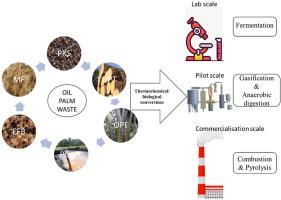Biomass & Bioenergy ( IF 5.8 ) Pub Date : 2021-07-14 , DOI: 10.1016/j.biombioe.2021.106179 H.A. Umar 1, 2 , S.A. Sulaiman 1 , M.A. Meor Said 1 , A. Gungor 3 , M. Shahbaz 4 , M. Inayat 1 , R.K. Ahmad 1

|
The conversion of oil palm waste to valuable fuels via biological and thermochemical means has witnessed much interest from researchers. Increasing tonnes of palm waste resulting from about 400 palm oil mills across Malaysia necessitates a rethink towards its conversion to energy to curb soil and air pollution, underground water contamination, and pest habitats. Converting these palm wastes to fuel at a commercial scale is necessary to advance Malaysia's bioenergy. This will ensure cleaner production and sustainability by providing low carbon energy that could be used in industrial, transport, and residential sectors. However, what is the technology readiness levels of these conversion methods in Malaysia? Have they reached commercialisation? What hinders them from attaining it? This study conducted an intensive literature review on five conversion technologies broadly classified as thermochemical (combustion, gasification and pyrolysis) and biological (anaerobic digestion and fermentation) to identify the extent to which each process has been adopted. For each of the technologies, the following were established: (1) Studies conducted by researchers using different palm wastes; (2) Challenges faced; (3) Technology readiness level. The significant findings revealed that fermentation is still at a lab scale, gasification and anaerobic digestion have reached pilot-scale while combustion and pyrolysis have attained commercialisation. Significant commercialisation challenges include technical and economic issues, communal consciousness, and stakeholder gap. Current research gaps, recommendations, future outlooks, and the way forward were discussed, along with developing a framework that features the key barriers, enablers, and stakeholders responsible for commercialisation.
中文翻译:

评估马来西亚油棕废料转化方法的实施水平和商业化的挑战:迈向可持续能源生产
通过生物和热化学方法将油棕废料转化为有价值的燃料引起了研究人员的极大兴趣。马来西亚约 400 家棕榈油厂产生的棕榈废料吨数不断增加,因此需要重新考虑将其转化为能源,以遏制土壤和空气污染、地下水污染和害虫栖息地。将这些棕榈废料转化为商业规模的燃料对于推进马来西亚的生物能源是必要的。这将通过提供可用于工业、运输和住宅部门的低碳能源来确保清洁生产和可持续性。然而,马来西亚这些转换方法的技术准备水平如何?他们达到商业化了吗?是什么阻碍了他们实现它?本研究对广泛归类为热化学(燃烧、气化和热解)和生物(厌氧消化和发酵)的五种转化技术进行了深入的文献综述,以确定每种工艺的采用程度。对于每种技术,建立了以下内容: (1) 研究人员使用不同的棕榈废料进行的研究;(2) 面临的挑战;(3)技术准备水平。重要发现表明,发酵仍处于实验室规模,气化和厌氧消化已达到中试规模,而燃烧和热解已实现商业化。重大的商业化挑战包括技术和经济问题、社区意识和利益相关者差距。讨论了当前的研究差距、建议、未来前景和前进的道路,同时制定了一个框架,其中包含负责商业化的关键障碍、推动因素和利益相关者。









































 京公网安备 11010802027423号
京公网安备 11010802027423号